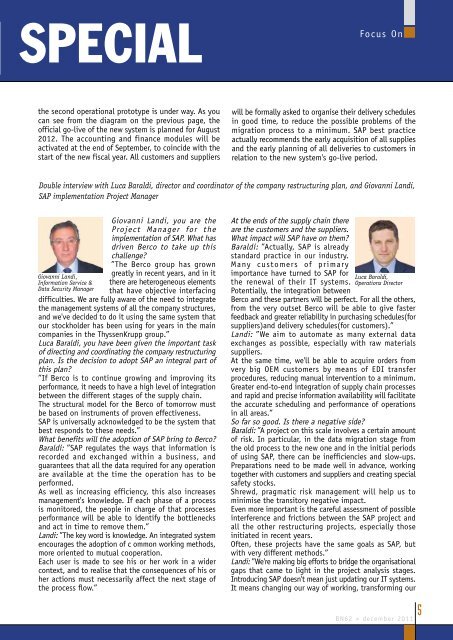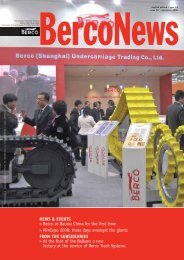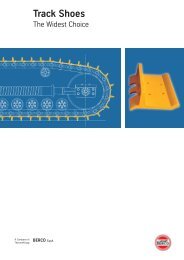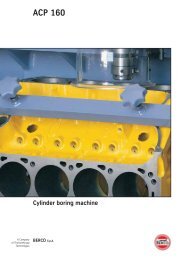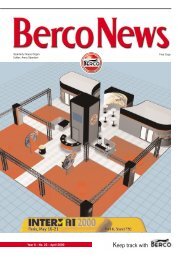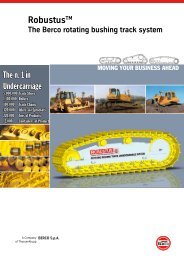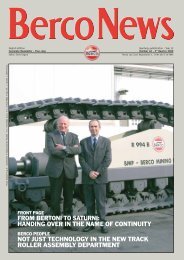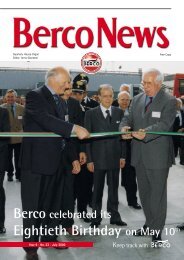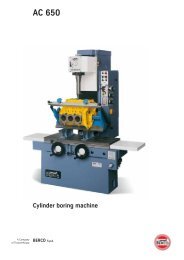about berco - Berco S.p.A
about berco - Berco S.p.A
about berco - Berco S.p.A
Create successful ePaper yourself
Turn your PDF publications into a flip-book with our unique Google optimized e-Paper software.
SPECIAL<br />
Focus On<br />
the second operational prototype is under way. As you<br />
can see from the diagram on the previous page, the<br />
official go-live of the new system is planned for August<br />
2012. The accounting and finance modules will be<br />
activated at the end of September, to coincide with the<br />
start of the new fiscal year. All customers and suppliers<br />
will be formally asked to organise their delivery schedules<br />
in good time, to reduce the possible problems of the<br />
migration process to a minimum. SAP best practice<br />
actually recommends the early acquisition of all supplies<br />
and the early planning of all deliveries to customers in<br />
relation to the new system's go-live period.<br />
Double interview with Luca Baraldi, director and coordinator of the company restructuring plan, and Giovanni Landi,<br />
SAP implementation Project Manager<br />
Giovanni Landi,<br />
Information Service &<br />
Data Security Manager<br />
Giovanni Landi, you are the<br />
Project Manager for the<br />
implementation of SAP. What has<br />
driven <strong>Berco</strong> to take up this<br />
challenge<br />
”The <strong>Berco</strong> group has grown<br />
greatly in recent years, and in it<br />
there are heterogeneous elements<br />
that have objective interfacing<br />
difficulties. We are fully aware of the need to integrate<br />
the management systems of all the company structures,<br />
and we've decided to do it using the same system that<br />
our stockholder has been using for years in the main<br />
companies in the ThyssenKrupp group.”<br />
Luca Baraldi, you have been given the important task<br />
of directing and coordinating the company restructuring<br />
plan. Is the decision to adopt SAP an integral part of<br />
this plan<br />
”If <strong>Berco</strong> is to continue growing and improving its<br />
performance, it needs to have a high level of integration<br />
between the different stages of the supply chain.<br />
The structural model for the <strong>Berco</strong> of tomorrow must<br />
be based on instruments of proven effectiveness.<br />
SAP is universally acknowledged to be the system that<br />
best responds to these needs.”<br />
What benefits will the adoption of SAP bring to <strong>Berco</strong><br />
Baraldi: ”SAP regulates the ways that information is<br />
recorded and exchanged within a business, and<br />
guarantees that all the data required for any operation<br />
are available at the time the operation has to be<br />
performed.<br />
As well as increasing efficiency, this also increases<br />
management's knowledge. If each phase of a process<br />
is monitored, the people in charge of that processes<br />
performance will be able to identify the bottlenecks<br />
and act in time to remove them.”<br />
Landi: ”The key word is knowledge. An integrated system<br />
encourages the adoption of c ommon working methods,<br />
more oriented to mutual cooperation.<br />
Each user is made to see his or her work in a wider<br />
context, and to realise that the consequences of his or<br />
her actions must necessarily affect the next stage of<br />
the process flow.”<br />
At the ends of the supply chain there<br />
are the customers and the suppliers.<br />
What impact will SAP have on them<br />
Baraldi: ”Actually, SAP is already<br />
standard practice in our industry.<br />
Many customers of primary<br />
importance have turned to SAP for<br />
the renewal of their IT systems.<br />
Potentially, the integration between<br />
Luca Baraldi,<br />
Operations Director<br />
<strong>Berco</strong> and these partners will be perfect. For all the others,<br />
from the very outset <strong>Berco</strong> will be able to give faster<br />
feedback and greater reliability in purchasing schedules(for<br />
suppliers)and delivery schedules(for customers).”<br />
Landi: ”We aim to automate as many external data<br />
exchanges as possible, especially with raw materials<br />
suppliers.<br />
At the same time, we'll be able to acquire orders from<br />
very big OEM customers by means of EDI transfer<br />
procedures, reducing manual intervention to a minimum.<br />
Greater end-to-end integration of supply chain processes<br />
and rapid and precise information availability will facilitate<br />
the accurate scheduling and performance of operations<br />
in all areas.”<br />
So far so good. Is there a negative side<br />
Baraldi: ”A project on this scale involves a certain amount<br />
of risk. In particular, in the data migration stage from<br />
the old process to the new one and in the initial periods<br />
of using SAP, there can be inefficiencies and slow-ups.<br />
Preparations need to be made well in advance, working<br />
together with customers and suppliers and creating special<br />
safety stocks.<br />
Shrewd, pragmatic risk management will help us to<br />
minimise the transitory negative impact.<br />
Even more important is the careful assessment of possible<br />
interference and frictions between the SAP project and<br />
all the other restructuring projects, especially those<br />
initiated in recent years.<br />
Often, these projects have the same goals as SAP, but<br />
with very different methods.”<br />
Landi: ”We're making big efforts to bridge the organisational<br />
gaps that came to light in the project analysis stages.<br />
Introducing SAP doesn't mean just updating our IT systems.<br />
It means changing our way of working, transforming our<br />
BN62 > december 2011 5


